Are you a Quiet Speculation member?
If not, now is a perfect time to join up! Our powerful tools, breaking-news analysis, and exclusive Discord channel will make sure you stay up to date and ahead of the curve.
I know many Modern players who read the January 18th ban announcement and wanted to eBay off their collections on the spot. Or burn them and overnight the charred Splinter Twin remnants to Wizards in Hallmark condolence cards. Have faith, ye Modern faithful! I too am deeply dissatisfied with Wizards' handling of this recent update, but I'm also a devoted Modern player who retains an unfailing optimism in the format's ability to adapt and evolve. It's time to lace up our boots and take a deep breath after getting the wind slugged out of us. Pack your bags, put a smile back on your face, and join me on the Great Modern Quest of 2016.
Is this the hunt for an Ancestral Vision unbanning? Not yet. An Innocent Blood reprint? Maybe next block. A new linear monster to replace Amulet Bloom? Let's hope not. Instead, come with me as we start to answer the most important Modern question of 2016: what deck(s) will fill the metagame gap left by Splinter Twin's banning?

As I've mentioned in previous articles, URx Twin and BGx Midrange formed a buddy-cop duo that regulated Modern and kept degenerate decks at bay. Its absence will likely cause a short-term uptick in linear decks such as Affinity, Tron, and Infect (among others). I believe we will push past this initial imbalance and return to the same format diversity we enjoyed throughout much of 2015, but a Twin successor will be an integral player in this narrative. Today's article is a first step towards finding an inheritor to Twin's mantle. I'll identify the three most important themes contributing to the strategy's success, giving some suggestions about how these can play out in months to come. Our search may be a fool's errand. Maybe URx Twin was the only "Twin" deck and no replacement exists. Perhaps Modern doesn't even need a Twin replacement at all! We can't know until we look, and that's where our journey begins.
[wp_ad_camp_1]
The Importance of Internal Regulation
Some of you will likely challenge this article's very premise, asking if we even need a URx Twin alternative when Wizards just took a bite out of the original. After all, didn't Twin get banned for reducing format diversity? If my time with Modern Nexus has taught me anything, it's the importance of policing decks in our format's metagame. Twin and BGx Midrange were the top cops on that block. We saw this in monthly update after monthly update, and today I want to highlight some of these 2015 examples to illustrate why regulators like Twin are important. This will dovetail with the more conventional theories about Twin's relevance, but with an added layer of data often missing from such assessments.
Checks and Balances in Early 2015
As with all quests, this one starts at the beginning. Back in February 2015, right after Birthing Pod and the broken delve sorceries were sent to the gallows, Modern was  a wide open format once again. Pro Tour Fate Reforged was right around the bend and everyone was excited for a new metagame. At least, until most people took a gander at one of the least balanced Pro Tour fields in recent memory. Day 2 saw about 30% of the field on some kind of Abzan (overwhelmingly the generic Abzan Midrange with a few Abzan Liege upstarts). The next four decks after Abzan were all linear sledgehammers: Burn (12.4%), Infect (7.4%), Affinity (6.6%), and Zoo (5.4%). Add RG Tron (3.1%), Storm (2.3%), Amulet Bloom (1.9%), plus a few other random stragglers, and you had a metagame that was even more linear than it was Abzan.
a wide open format once again. Pro Tour Fate Reforged was right around the bend and everyone was excited for a new metagame. At least, until most people took a gander at one of the least balanced Pro Tour fields in recent memory. Day 2 saw about 30% of the field on some kind of Abzan (overwhelmingly the generic Abzan Midrange with a few Abzan Liege upstarts). The next four decks after Abzan were all linear sledgehammers: Burn (12.4%), Infect (7.4%), Affinity (6.6%), and Zoo (5.4%). Add RG Tron (3.1%), Storm (2.3%), Amulet Bloom (1.9%), plus a few other random stragglers, and you had a metagame that was even more linear than it was Abzan.
Once players began processing event data, however, things looked significantly better. Adrian Sullivan wrote an excellent piece on these numbers, which I'll draw on here. With the exception of Infect, which was extremely well-positioned against Abzan, all of the most-played linear 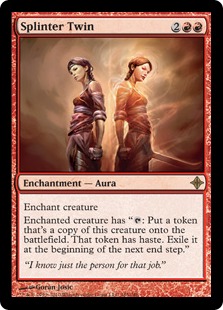 decks imploded en route to the 18+ points bracket. Burn, Affinity, and Zoo all posted sub-15% conversion rates, which was partly to be expected given how many people were on the decks, but moreso a testament to their positioning: the decks weren't as good as many believed. Meanwhile, good old UR Twin had a rock solid 18% conversion rate (second of all the decks with 12+ players). Antonio Del Moral Leon also won the entire event with his list. Following the Pro Tour, Grand Prix Vancouver flipped the metagame narrative on its head, with URx Twin immediately seizing the Day 2 crown at 18.5%, sending four players to the Top 16, and giving Dan Lanthier his win. This reversal from linear infestation to Twin regulation could find a parallel in the months to come.
decks imploded en route to the 18+ points bracket. Burn, Affinity, and Zoo all posted sub-15% conversion rates, which was partly to be expected given how many people were on the decks, but moreso a testament to their positioning: the decks weren't as good as many believed. Meanwhile, good old UR Twin had a rock solid 18% conversion rate (second of all the decks with 12+ players). Antonio Del Moral Leon also won the entire event with his list. Following the Pro Tour, Grand Prix Vancouver flipped the metagame narrative on its head, with URx Twin immediately seizing the Day 2 crown at 18.5%, sending four players to the Top 16, and giving Dan Lanthier his win. This reversal from linear infestation to Twin regulation could find a parallel in the months to come.
As an amusing historical note, Amulet Bloom proved remarkably resilient to Twin's policing during this era. Despite its supposedly subpar matchup, Bloom still managed excellent conversion rates at the Pro Tour and notable Top 8s at both the Pro Tour and the Grand Prix. Part of this was opponent's inexperience, but it also speaks directly to Bloom's strength and eventual ban this year.
Fighting the Linear Menace of Fall 2015
There are a few more instances of Twin's regulatory effects (beating back big-mana decks at Grand Prix Charlotte, keeping Amulet Bloom at the bottom edge of Tier 1 in November, etc.), but my favorite came in the September, October, and November metagame snapshots. Starting in July and moving through September, 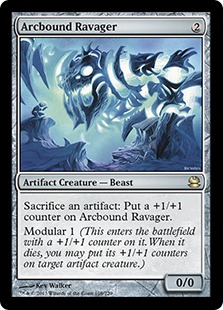 we had seen a gradual Twin decline as players tinkered with Grixis alternatives and moved off their trusty combo. The result was a massive Affinity spike, culminating in the robots' 11% share in September, a 4% leap from August. October also saw an alarmingly linear Grand Prix Porto Alegre, a Burn and Affinity hegemony at the SCG States events, and Tron's continual rise from Tier 2 wallflower to Tier 1 mainstay. Gruul Zoo even hit Tier 2 for the first time since I started analyzing Modern numbers in 2014. With all these different pressures, especially a seemingly unstoppable Affinity preying on the false sense of Kolaghan's Command confidence, Modern was looking much sicker than it had in June.
we had seen a gradual Twin decline as players tinkered with Grixis alternatives and moved off their trusty combo. The result was a massive Affinity spike, culminating in the robots' 11% share in September, a 4% leap from August. October also saw an alarmingly linear Grand Prix Porto Alegre, a Burn and Affinity hegemony at the SCG States events, and Tron's continual rise from Tier 2 wallflower to Tier 1 mainstay. Gruul Zoo even hit Tier 2 for the first time since I started analyzing Modern numbers in 2014. With all these different pressures, especially a seemingly unstoppable Affinity preying on the false sense of Kolaghan's Command confidence, Modern was looking much sicker than it had in June.
 Deceiver Exarch, to the rescue! The November update saw most of these October and September trends retreat as the format rebalanced itself around this format pillar. We saw the beginnings of Twin's return in October, when the traditional UR version climbed 1%, and this continued into November when it jumped another 1% and dominated the RPTQ circuit with a 15% share across tournaments. Although RG Tron (and that darn Amulet Bloom) solidified its Tier 1 status in this time period, all the other linear decks dropped back into equilibrium. Twin's resurgence was integral to that change: one need only watch the Grand Prix Pittsburgh Top 8 to see this principle in action.
Deceiver Exarch, to the rescue! The November update saw most of these October and September trends retreat as the format rebalanced itself around this format pillar. We saw the beginnings of Twin's return in October, when the traditional UR version climbed 1%, and this continued into November when it jumped another 1% and dominated the RPTQ circuit with a 15% share across tournaments. Although RG Tron (and that darn Amulet Bloom) solidified its Tier 1 status in this time period, all the other linear decks dropped back into equilibrium. Twin's resurgence was integral to that change: one need only watch the Grand Prix Pittsburgh Top 8 to see this principle in action.
All of this is to give some hard data behind the common assertion about Twin's regulatory role in Modern. Twin's presence may have pushed out other options, but this is true of any Tier 1 deck. More importantly, Twin played an important role as a format policeman, something we see in the data above. We won't be getting the enchantment back anytime soon, but this analysis underscores the importance of finding a replacement to Twin if we can. Modern will likely fall out of balance in the future, just as it did over 2015. When that happens (not "if"), we'll want Twin's successor lined up to Restore Balance.
Rising to the Twin Challenge
Now that we've given some important quantitative and qualitative context to Twin's importance, we have a better understanding of what's at stake in a Twinless Modern. This should galvanize us to find a Twin successor. Reflecting on the URx Twin role over 2015 (and in earlier years), I've identified three larger themes to the deck's success that Twin successors will need to meet. There's a long line of candidates for the job, and if we are to successfully separate the next big thing from wasteful flops, we'll need to see how the applicants meet (or don't meet) these criteria.
Criterion 1: Always Threaten the Win
If there was any single secret to Twin's success, it was its ability to always threaten a win starting on turn three. The very fear of an Exarch/Twin 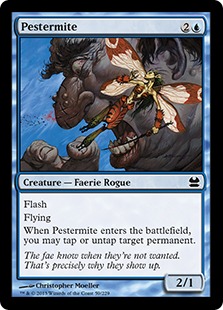 combo forced players to keep mana open and lose tempo even if the Twin player didn't have the combo and the opponent didn't have the interaction. This abject terror demanded you mulligan away certain hands and sideboard certain cards. It required foes to scry defensively off Serum Vision, maindeck a Spellskite or Qasali Pridemage bullet, and hold back multiple burn spells just to combat the four-toughness Exarch. Ban supporters will point to this commanding table presence as a justification for Twin's banning and I counter that it was a necessary consequence of nonrotating formats having strong, regulatory decks. Let's table that discussion for now and just agree that if we want a true URx Twin successor, it needs to hold the same kind of fear and respect as the original Splinter Twin.
combo forced players to keep mana open and lose tempo even if the Twin player didn't have the combo and the opponent didn't have the interaction. This abject terror demanded you mulligan away certain hands and sideboard certain cards. It required foes to scry defensively off Serum Vision, maindeck a Spellskite or Qasali Pridemage bullet, and hold back multiple burn spells just to combat the four-toughness Exarch. Ban supporters will point to this commanding table presence as a justification for Twin's banning and I counter that it was a necessary consequence of nonrotating formats having strong, regulatory decks. Let's table that discussion for now and just agree that if we want a true URx Twin successor, it needs to hold the same kind of fear and respect as the original Splinter Twin.
Naturally, for the threat of a win to be omnipresent, the win condition must itself meet some benchmarks.
- Surprising
An opponent shouldn't see your win coming. If victory requires you to play a permanent and then untap with it a turn later, you aren't always threatening the win. Why? Because when that linchpin permanent isn't in play, your opponent has nothing to fear. As long as you have cards in hand, your enemies should be sweating in the knowledge you might win at any moment.
- Fast
You need to execute your big win no later than turn five. Ideally, it should be turn four or earlier. On the play, you really need your opponent to sacrifice their vital turn three Liliana of the Veil or Tasigur, the Golden Fang because they needed to hold up Terminate mana: there's a huge power gap between turn three and turn two plays in Modern, and we want opponents to make the tough choice. With enough disruption, you can push this up a turn, but only if you have powerful interaction along the way (e.g. Anger of the Gods, Supreme Verdict). Anything past turn five is too slow.
- Decisive
Our Twin 2.0 win condition must end the game on the spot unless an opponent immediately interacts with it. Virtual wins won't always cut it. A turn four Ulamog, the Ceaseless Hunger might spell certain doom to the opposing Grixis mage, but the Burn pilot is going to gleefully answer double Vindicate with double Lightning Bolt. The win doesn't need to be guaranteed in all corner cases (Scapeshift counts even if Soul Sisters and Abzan Company laugh at Valakuts), but it should be final in the vast majority of matches.
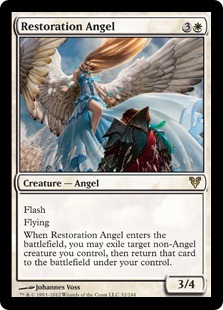 These three qualifications are best served by single card combos that don't require a lot of setup (Scapeshift), instant-speed cards you can cast without warning (Restoration Angel, Gifts Ungiven), and synergies that don't leave room for response (Through the Breach into Primeval Titan won't end the game immediately in most cases). Based on that, here's a brief and nonexhaustive list of cards and combos which might meet the "always threaten the win" criterion.
These three qualifications are best served by single card combos that don't require a lot of setup (Scapeshift), instant-speed cards you can cast without warning (Restoration Angel, Gifts Ungiven), and synergies that don't leave room for response (Through the Breach into Primeval Titan won't end the game immediately in most cases). Based on that, here's a brief and nonexhaustive list of cards and combos which might meet the "always threaten the win" criterion.
- Restoration Angel and Kiki-Jiki, Mirror Breaker
- Deceiver Exarch and Kiki-Jiki, Mirror Breaker
- Scapeshift
- Through the Breach into Emrakul, the Aeons Torn
- Gifts Ungiven for Unburial Rites and fatty
I'm leaving off a lot of "I win" synergies because they might not support the other two criteria (sorry, dear Goblin Charbelcher), but this is still a great starting point before we incorporate our other parameters.
Criterion 2: Role Flexibility
If you take on the URx Twin mantle, you'll find yourself in positions where your primary win condition isn't online. Maybe an opponent 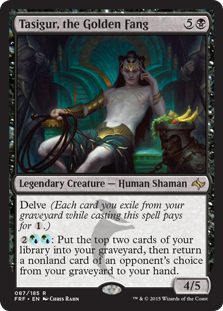 Thoughtseized the pieces. Perhaps they are presenting removal mana. Either way, our heir to the throne must be able to shift gears into a new role to beat the hate and emerge victorious. Twin was notorious for this approach, achieved in Game 1 with reach from Snapcaster Mage, Lightning Bolt, and Pestermite, and augmented in Games 2-3 with haymakers like Keranos, God of Storms. Temur and Grixis variants accomplished this with a midrange gameplan courtesy of Tarmogoyf and Tasigur, the Golden Fang, while Alex Bianchi's Jeskai list leveraged Celestial Colonnade. Of course, this gear-shifting must never preclude the threat of our primary win condition. Opponents need to think twice before spending valuable interaction on a rogue Tarmogoyf, lest we Exarch them out in response.
Thoughtseized the pieces. Perhaps they are presenting removal mana. Either way, our heir to the throne must be able to shift gears into a new role to beat the hate and emerge victorious. Twin was notorious for this approach, achieved in Game 1 with reach from Snapcaster Mage, Lightning Bolt, and Pestermite, and augmented in Games 2-3 with haymakers like Keranos, God of Storms. Temur and Grixis variants accomplished this with a midrange gameplan courtesy of Tarmogoyf and Tasigur, the Golden Fang, while Alex Bianchi's Jeskai list leveraged Celestial Colonnade. Of course, this gear-shifting must never preclude the threat of our primary win condition. Opponents need to think twice before spending valuable interaction on a rogue Tarmogoyf, lest we Exarch them out in response.
Taking the Twin example, we'll either want a tempo or a control Plan B to our Plan A. It's no coincidence many considered URx Twin the "true" control deck of the format, something showcased in every game where Brian Braun-Duin packed his own UR Twin list. Indeed, in many respects, we wouldn't be wrong describing Twin as a Plan A tempo or control deck with a combo Plan B! This role fluidity makes in-game decisions and sideboarding significantly harder than if we were a pure combo deck. Opponents must weigh disrupting the combo against interacting with our Plan B, which often necessitates different spells and lines of play. Our role flexibility gets weaker if opponents can answer both dimension of our strategy with a single card: Jeskai Twin had great positioning at Pittsburgh because bullets that stopped the Twin combo were useless against Colonnade.
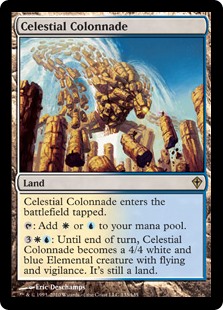 Focusing on tempo and control options (although it would be interesting to explore aggro or ramp ones at a later time), here are some frontrunning cards and combinations we'll want to remember as we craft the Twin successor.
Focusing on tempo and control options (although it would be interesting to explore aggro or ramp ones at a later time), here are some frontrunning cards and combinations we'll want to remember as we craft the Twin successor.
- Tempo threats: Vendilion Clique, Pestermite, Restoration Angel
- Manlands: Celestial Colonnade, Wandering Fumarole, Lumbering Falls
- Early clocks: Tarmogoyf, Tasigur, the Golden Fang, Geist of Saint Traft
- Burn reach: Snapcaster Mage, Lightning Bolt, Lightnign Helix, Electrolyze
- Haymakers: Keranos, God of Storms, Jace, Architect of Thought, Ajani Vengeant
We'll want to focus on these categories as we outfit our deck for post-banning success.
Criterion 3: Bolt, Remand, and Snapcaster
In highlighting these three staples, I point both to the cards themselves and also the effect they represent. Twin enjoyed so much success not 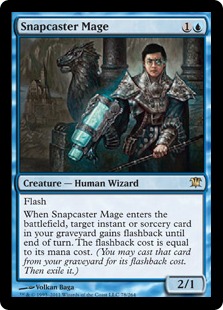 only because it leveraged these Modern icons themselves, but also because it capitalized on the advantage they presented in games. Lightning Bolt is the cheap removal spell that allows early interaction, gives options in the midgame, and widens reach into later turns. Remand is the virtual time walk that punishes flashy and expensive plays, steals tempo, and buys time for either your Plan A or your Plan B. As for Snapcaster Mage, the Wizard requires little introduction: he's arguably (read: probably) the best card in Modern and is one of the only cards that appreciates in value at every stage of the game. Without these three effects, Twin would not have been the powerhouse we remember it as, and although Splinter Twin is gone today, its royal guard remains.
only because it leveraged these Modern icons themselves, but also because it capitalized on the advantage they presented in games. Lightning Bolt is the cheap removal spell that allows early interaction, gives options in the midgame, and widens reach into later turns. Remand is the virtual time walk that punishes flashy and expensive plays, steals tempo, and buys time for either your Plan A or your Plan B. As for Snapcaster Mage, the Wizard requires little introduction: he's arguably (read: probably) the best card in Modern and is one of the only cards that appreciates in value at every stage of the game. Without these three effects, Twin would not have been the powerhouse we remember it as, and although Splinter Twin is gone today, its royal guard remains.
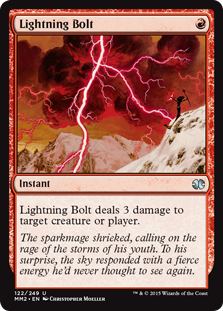 Unlike my last two criteria, this one is color-specific. You need to be in URx to abuse Modern's Bolt/Remand/Snapcaster trinity, which naturally places some deckbuilding restrictions on any post-Twin strategies. I don't have a problem with these constraints. Bolt is going to be more important than ever in a metagame swarming with Wild Nacatls, Goblin Guides, Signal Pests, and (Bl)Inkmoths. The same is true of Snapcaster, which will remain the best reason to play blue until/unless they ever unban Jace, the Mind Sculptor. Some have argued Twin was not the best deck because of the combo in itself, but because it was the best way to build around Snapcaster Mage. I won't disagree with this, and we'll want to make a similar commitment in 2016.
Unlike my last two criteria, this one is color-specific. You need to be in URx to abuse Modern's Bolt/Remand/Snapcaster trinity, which naturally places some deckbuilding restrictions on any post-Twin strategies. I don't have a problem with these constraints. Bolt is going to be more important than ever in a metagame swarming with Wild Nacatls, Goblin Guides, Signal Pests, and (Bl)Inkmoths. The same is true of Snapcaster, which will remain the best reason to play blue until/unless they ever unban Jace, the Mind Sculptor. Some have argued Twin was not the best deck because of the combo in itself, but because it was the best way to build around Snapcaster Mage. I won't disagree with this, and we'll want to make a similar commitment in 2016.
 Remand is also a worthy contributor to the Twin cause, although it's relevance is more questionable today than it was three months ago. Rising linear decks in the Stage 1 Twinless world will be poor targets for Remand's talents. Much more worryingly, Bx Eldrazi decks circumvent the tempo loss with Blight Herder's and Oblivion Sower's on-cast effects. Remanding a turn three Karn Liberated is as good as it gets. Remanding the turn four Ulamog, the Ceaseless Hunger? Not so much. These decks make the counterspell much worse than it was in an earlier metagame, benefiting from the double-cast and often having enough mana to negate it early. Because of this, our Twin successor might need to evolve beyond its Remand origins, even if we keep the instant in mind if the format becomes more hospitable.
Remand is also a worthy contributor to the Twin cause, although it's relevance is more questionable today than it was three months ago. Rising linear decks in the Stage 1 Twinless world will be poor targets for Remand's talents. Much more worryingly, Bx Eldrazi decks circumvent the tempo loss with Blight Herder's and Oblivion Sower's on-cast effects. Remanding a turn three Karn Liberated is as good as it gets. Remanding the turn four Ulamog, the Ceaseless Hunger? Not so much. These decks make the counterspell much worse than it was in an earlier metagame, benefiting from the double-cast and often having enough mana to negate it early. Because of this, our Twin successor might need to evolve beyond its Remand origins, even if we keep the instant in mind if the format becomes more hospitable.
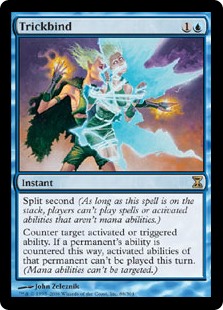 Bolt-Snap-Bolt doesn't have replacements, but there are plenty of viable alternatives to Remand's place in the Twin picture. Here are just a few I'm scoping for future brews.
Bolt-Snap-Bolt doesn't have replacements, but there are plenty of viable alternatives to Remand's place in the Twin picture. Here are just a few I'm scoping for future brews.
- Trickbind
- Squelch
- Mana Leak
- Logic Knot
- Voidslime
- Bant Charm
I'm nervous about the three-mana alternatives, but very interested in the rest. Modern might not have Stifle or Counterspell, but some of their replacements might be good enough in the right shell.
The Search is On!
It might feel oversimplistic to distill URx Twin's enduring success to just three themes when so many other internal factors and external contexts were at play. These possible complications aside, I'm comfortable starting with this trio as we look for the next contender to take up Twin's fallen sword. We can add to them as we learn more about the new metagame, and adapt them as we see what a Twinless Modern looks like. You can bet I'll be brewing, testing, and crunching the numbers to see what comes next.
What deck do you think will inherit the Twin tradition? Any tech you're keeping an eye on? Do you even believe Modern needs a Twin deck, or that Twin was the policing force I make it out to be? Take it into the comments and I'll see you all there as we navigate this new format together! I'll be posting a Part 2 to this piece in the coming week after I've conducted some more tests.






I have been looking at various replacements for twin since the ban, and the one that has stuck out to me is Thopter Engineer into Shape Anew for Blightsteel Colossus. While it notably does play at instant speed, the combo fits easily into other URx shells that historically have been successful such as Blue Moon, Grixis Midrange and Jeskai. This combo pears well with cards used in those strategies such Blade Splicer, Resto, Pia and Kiran, and Jace, Vryn’s Prodigy, perhaps more than the Twin Combo has. So while Shape Anew is more vulnerable than Twin (a thopter can always be bolted), the potential to play a fair game in game one is much greater.
I’m curious as to whether you have heard of this strategy before and what placd you think it could have in the meta.
That’s actually quite brilliant! I love this combo! Coming from a former Grixis Twin player, you have given me hope, I can’t wait to try this!
its not surprising or decisive would be my view. seems like it would struggle to do well in the meta.
As a preface, I would like to note that this deck is currently untested.
I don’t think there will be a combo that is quite as effective as Twin was, and I don’t think looking for an exact replacement will be fruitful.
The value I see in this combo is having an “Oops I win” out to draw towards in shells that have historically lacked in closing speed (Blue Moon, Grixis, Jeskai). The element of surprise isn’t as necessary against other linear strategies, as they are limited in how they interact with you anyway. You also have the potential to sideboard into other bombs that are decisive in their respective matchups (ie Sphinx of the Steel Wind vs Burn/Zoo).
I’ve tinkered with Polymorph and Shape Anew in the past and haven’t found either combo to be that terrible. Blightsteel is definitely more vulnerable than Emrakul, although the former at least allows you to run creatures instead of ditching them entirely for Polymorph.
Such a deck could definitely be strong, but it lacks the surprise value of Twin and thus the major tempo advantage that made Twin so good. That said, I am definitely experimenting with a more token-heavy take on this, using an instant-speed token generator on turn three (Warping Wail rocks here) to set up a turn four Polymorph. Unfortunately, this leaves you tapped out without a win until turn five, so we’ll have to see. Honestly, I’m having a bit more success with Through the Breach and Emrakul, which is a bit harder to set up but doesn’t leave you naked on turn four.
I kinda prefer WB Tokens as a shell for Polymorph – it’s pretty good at slowing down most of the linear decks anyway, with its infinite blockers and maindeck lifegain. Splashing Blue isn’t much of a cost.
“I’m leaving off a lot of “I win” synergies because they might not support the other two criteria (sorry, dear Goblin Charbelcher),” . . .
The saddest 22 words I’ve seen on the Internet this year.
I promise we’ll see more Belcher in the new year, at least from this site! Twin was a major impediment to Forest Belcher’s/8 Land Belcher’s success, so its departure opens up a lot of room for the deck to succeed. It might not be a very good deck, however, so there’s some uncertainty around how strong it would be even with Twin gone.
Imo, there are currently 3 decks on my mind, which can take Twins position:
1) Scapeshift
It has a fast clock, early interaction and is the best Cryptic deck in Modern. Furthermore, it can pack MD sweepers, which will be crucial in the next couple of weeks (heck, even months).
2) Naya Zoo
Yes, I know, it is not in the URx colour scheme, however, Zoo has historically had a good aggro match-up (cause it has the bigger creatures) AND had a decent big mana match-up. Only Combo and depending on the build Midrange was a problem. However, I think, with the right build, it might be able to beat the two “problematic” archetypes in the next time: Hyperaggro and Big Mana decks.
It helps, that it can run Blood Moon effects MD.
3) A Gifts Ungiven deck:
I don’t think, that Rites + Fatty will be enough going forward (heck, it wasn’t even that good in the last couple of months), but I would rather look at the Ritual Gifts version (I played it myself pre Song ban). The combo is rather slim (12-14 cards, depending on which configuration you want to run) and often needs only a single Gifts Ungiven to win on the spot (note: you have to untap first to be able to go off).
Notable mentions but excluded since no “combo” deck: RUG Delver (Monkey Grow build – cause good combo and aggro match-up) and UWR Geist (fast clock + enough interaction vs Aggro).
Greetings,
Kathal
Agree on Gifts and Scapeshift. Interesting take on Zoo! I do think there’s a lot of potential for the Zoo core to adapt for this new metagame, and I imagine players like Kibler will be at the forefront of these developments. That said, I think it lacks the big “I Win” play of Twin. Even the Knightfall versions aren’t quite the same, and that was a major piece of Twin’s success. Totally possible we will never find a Twin successor, but I like starting with Scapeshift and Gifts.
You don’t “need” a opps I win combo, if you pressure the opponent starting with Turn 1. Twin did “nothing” in the first 2 turns (Serum Visions, Bold and Remand were the most common plays, and those cannot compete with stuff like Nacal into Goyf), while Zoo starts kicking your ass.
I know this from the RUG Delver/Prowess deck I’m currently playing. Having a fast clock AND interaction is most of the times enough vs those problematic decks. Also, the “mini” combo in my deck is Become Immense + unblocked dude. Easy to deal 10 damage with a single swing (due to Prowess) which should be enough to finish the game in that or next turn.
Greetings,
Kathal
I think we’re just talking about slightly different things. You can have a very good deck that fills Twin’s position without also having a winning combo that comes out of nowhere. But I wouldn’t really call that deck a direct Twin successor because it doesn’t have the “if you tap out on turn three you might lose regardless of my/your board position” threat. That doesn’t work with permanent-based combos because if the permanent isn’t in play, your opponent has nothing to fear and can tap out freely.
Not saying a Temur Prowess or Monkey Grow/RUG Delver style deck isn’t good. I think those decks are quite decent right now. Just that those decks wouldn’t be direct Twin replacements because they can’t accomplish #1 quite the same way Twin did.
Hey, I’m a regular Bring to Light Shift player and I’ve been having good results with it, I’m now experimenting on fusing the BTL build with Gifts to give us a better aggro win (we can frequently T3 gifts into T4 unburial->Elesh vs aggro) though I’ll need to see what the more stressed mana base will require (26 land) and whether gifts and BTL will non-bo frequently (Elesh in hand without an Izzet Charm would suck)
i generally like the kiki shell as a replacement for twin but there are lot of restrictions attached to him given his mana requirements… you really have to go out of your way to get RRR outside of UR and kiki leverages resto the best so there’s a lot of motivation to go UWR but that’s where his mana requirements really get in the way….
i do think UWR kiki will pop up and might breakthrough depending on the exact list…. it has all the tools to survive to the mid game plus the sideboard to plug up deficient matchups… i actually thought that jeskai twin was really well positioned given how powerful stony silence was going to be before the bans…
I’m optimistic about Kiki Control’s chances, even with Kiki’s prohibitive mana cost. Jeskai Control seems decent in a very linear metagame, and a proactive addition could make it a real contender. Excited to see what others brew up for the upcoming events!
I’ve been testing UWR Kiki a lot in the last month on Xmage, where everyone’s playing the new cards.
My list is close to the 2013 players championship deck piloted by shahar shenhar, but with a couple Kiki. His sideboard made the deck pretty aggressive, where he could race the fast decks and combo decks.
I think it will be the level 2 deck in the company format. What I mean is that people are expecting a lot of linear big mama decks and so are opting to play fast, aggressive strategies like burn, zoo, and mono green stompy. UWR control decks match up well against these types of strategies. Against decks like TRON and Eldrazi, you go hard at their life total, backed up with some land destruction and a few counters.
It’s also a deck that is relatively strong to hand disruption, as it is a relatively homogenous deck. I was testing scapeshift before, which is weak to the discard and extraction effects that a lot of people are playing as catch all answers.
If there are people willing to learn the deck, Knightfall can take up the mantle. With Coco or chord, you threaten the get knight at instant speed. With knightfall, you are playing to the board as a plan A to keep the opponents off-balance for the combo, rather than using the combo to keep them off balance for plan B as one did for splinter twin.
The only reason this deck is not Tier 1 yet, imo, is a lack of people playing and learning the deck.
I agree with you this deck looks interesting. I think I am gonna proxy test this deck against other deck to see its potential, especially against my beloved burn deck.
Knightfall has potential. The Remand and Snapcaster loss is unfortunate, but it keeps Bolt and still meets the important Criterion 1 and Criterion 2. I also think Zoo is generally a good deck to bring to this current metagame, so we might see some Knightfall in our future if people figure out the best way to play and build it.
As burn player I have been waiting for you to talk about burn deck potential for the new meta either staying true to the classic or becoming unique burn deck. Nevertheless, tron, jund, and Affinity is what’ve been discussed on recent article, not that I mad.
Burn isnt worth talking about. It will always be around and it will always be a thing to watch out for since a lot of nubs pick up the deck while they try to learn the format. Eventually, they build real decks and complain about Burn, its a never ending cycle.
With so many cool things to do in Modern, it baffles me why people want to do something boring, like 3 to the face every turn. Unless, the reason is the costs of other decks or that they are too stupid to play real magic. I can respect either reason, but I wish they would just admit it.
Mindcrank combo?
It’s certainly decisive but it lacks the surprise element of Twin. This means opponents don’t have to respect it and suffer self-inflicted tempo loss for holding mana for interaction and the threat of interaction.That’s a major strike against the combo, although I still think it’s a neat brew.
I really like Hooglands Kikichord deck that has been so successful of late. I know criteria three isn’t fulfilled, but I feel like that condition is tough to reconcile with the previous two due to color restrictions. It covers the previous two perhaps even better than twin did, I would argue there isn’t a more surprising deck in modern. Maybe the objective is to do something remand like or bolt like, not necessarily with those cards. Wall of omens, path, and voice add their own strengths to the deck that can be compared to snap, remand, and bolt.
Maybe it’s worth considering there won’t be another twin? Maybe we should let it ride off into the sunset and try to make more of a spiritual successor instead of smashing something combo like into the UR shell. We don’t want a Kylo Ren twin deck.
Kiki Chord is certainly in a similar category to Blue Knightfall Zoo. It doesn’t really meet Criterion 3, but it passes pretty handily on #1 and #2 (which, I believe, are more important). Hoogland has had a lot of great runs with the deck, so maybe we see more of it as 2016 unfolds.
Yes, Kiki chord has been having a lot of succes and I see a lot of people playing it. It definitely has that surprise potential and can grind very well, though I don’t know how well it matches up against the really linear big mana decks or fast combo.
Hi! Sheridan, great article!
What do you think about ur storm in new twinless meta? I’ve been plaing twin for few years and now im thinking about storm. It looks solid against all linear aggro (except burn) and against eldrazi/ tron/ midranges.
About 1st term You wrote:
It has good chance to win at t4-5 without any earlier preparation at table (i think about casting ascension or electromancer at turn you want to combo)
2nd term:
Its harder but I thin that with correct sideboard it’s possible to turn into ur tempo deck (wich mean in 2nd game you may choose wich plan would you realize).
3rd:
Unfortunately i can not see snapcaster in ir storm… But maybe after thousands hour of testing :p
I would be very happy to hear what so You thin about it
Greetings!
Storm won’t be the Twin replacement because it requires way too many slots to fulfill #2, which was a major contributor to Twin’s success. That said, I do think Storm is well-positioned in this current metagame, especially if players are too preoccupied with creature-based aggro decks, ramp, and Affinity. That leaves a nice hole for Storm to, well, storm through.
Love the article!
The idea of replacing twin if really interesting. I hope this doesn’t happen, it I can see a future of modern where this conversation takes place and we start have dynasties
Currently I think Hooglands KIKI cord deck has probably some of the best chance of accomplishing what you want it to: it has game against every deck. It has a very good toolbix element, which could be crucial to combating these linear decks in the future, and it provides an instant tutorable win.
If not Hooglands list, I think a jeskai control deck is the way to go. I think the new red snapcastsr in oath looks like a promising one or two of to have a versatile ETB. And I don’t think it nessecarily needs a combo, just needs to combat the linear decks in a reasonable manner
Bottom line is I think White is crucial for the replacement, because of how many amazing sideboard cards its offers. The boogie men are infect, tron, affinity, and burn. White has the tools to combat all of those strategies and still compete with GBx.
I’m not totally confident a next level Twin is doable, but if it is possible, I think Jeskai Control and Kiki Chord are nice starting places. White generally seems well suited to this, whether in bodies like Restoration Angel, removal like Path, or manlands like Colonnade. As you also mention, it has great sideboard tools to handle the linear and ramp foes we’ll likely encounter after the ban goes into effect.
Thank you for the great article, it was a good read! Definitely agree that a new policing deck is needed in modern.
I’m really trying hard to make a control version of the jeskai Ascendancy Combo working again.
A 4c approach with manadudes accelerating into Gifts Ungiven are seemingly the nuts –> Life from the Loam + Flame Jab which will win the game with 2 manadudes. Lumbering falls seems very tempting as it provides a hexproof manaloop once activated and the much needed g/u mana.
In theory, the deck has all the sweetest things at hand: Explosive starts, instant speed combo setup, Bolt/Path/Remand/Snapcaster, alternative win cons in Lingering Souls/Loam + Ghost Quarter mana combo/hexproof manlands/potential to Gifts combo, blue library manipulation, and yes even Glittering Wish!
But it is hard to get the numbers right and to figure out a basic shell to begin with. I’ve seen some lists which go into the right direction but they are far away from its true potential I think.
Absolutely love the Jeskai Ascendancy “Control” version we saw Scott Kirkwood play at SCG Cincinnati. I don’t think it has quite the same surprise win-threat potential as Twin, but it fires on enough cylinders that it might not matter. It certainly has some strong Plan Bs in burn, Snapcaster, Unburial Rites, etc. I’d probably avoid the Glittering Wish version and stick with the Gifts package (which fits Criterion 1 much better than Wish does), but there’s still a lot of potential in all those variants.
Gifts/Ascencancy package seem to be the one that can shift it’s role from game to game on the go (thanks to Glittering Wish and powerful tutoring possibilities of Gifts Ungiven) and often finds itself in the position of being threatable enough to make an opponent to hold it’s answers. I mean, if you don’t put Ascendancy, you can just Unburial Rites in some heavy beater. And if you put Ascendancy, your opponent can’t do that much to stop you from that point: the engine is often ready to go. Add here some tempo-control elements and here we go, well-packed police toolbox deck to rule the format (at least I would love to hope so, lists look so sweet!).
Doesn’t Griselshoalbrand meet most of these requirements?
It’s fast (too fast), decisive (you are definitely dead) and surprising (any 2 cards could be hiding an instant speed win if you have the mana) and resiliant (never seen a combo deck happier to play off the top, where faithless looting in the graveyard or any of half a dozen cards actually say “I Win”). It can also switch from graveyard combo to spell combo in Through the Breach, or if you lock it out with Leylines and such, just change gears and play Worldspine Wurms till you die.
I think the combo you want as a replacement is eot Notion Thief into mainphase Day’s Undoing. I Draw 14, you dump your hand (and lose your graveyard, which is huge against quite a few modern decks) isn’t as decisive as Twin but its pretty much game over since you get to craft a perfect hand for the next few turns and still have mana up after Day for removal/counter.
The only situation where it is significantly worse than twin is if you are facing a lethal board, since Day may let them get one more swing in before you untap and sweep. But I’ve played this combo often enough to know that can be played around, and you can usually find something in the top 14 cards that saves you.
We get it, you are uspet with twin ban, lots of articles regarding why it’s bad and so on. Well, we just want to play modern, no whining please.